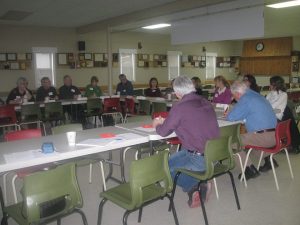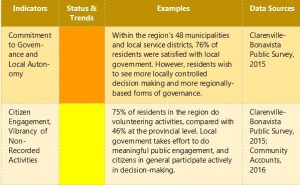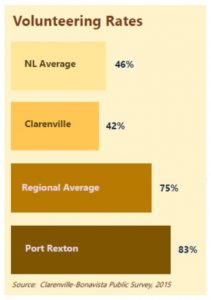Why is This Important?

The former Alliances for Community Engagement initiative brought together residents in different communities to discuss issues of common concern. Photo credit: Community Sector Council.
Good governance is more than just good government – it takes teamwork from citizens, organizations, businesses, and different levels of government working together to solve common challenges. Our region has many engaged leaders in the public, private, and non-profit sector who are working hard to improve quality of life in their communities. As we think about how to become a more sustainable region, we must work together across communities, sectors, and social groups to find new strategies that benefit people across the region and engage community members. We recommend that regional collaboration is best approached within the scale of each of the three unique regions – Bonavista, Clarenville, and the Isthmus – while looking for opportunities to mobilize leaders across regions where it is appropriate and mutually beneficial.
Key Indicators and Trends

This priority was assessed by considering two key elements of local governance. First, the commitment to effective governance  and increased regional autonomy was evaluated by asking residents in the 2015 survey how satisfied they were with local government. Overall, 76% of residents are satisfied with their town council, with some variation across communities. However, in recognition of the fact that municipal governments cannot control many decisions currently made by provincial or federal government, it is important to explore ways for different levels of government to work together and consider collaborative approaches to providing services and meeting citizens’ needs. One major opportunity for municipalities in the region to consider is the potential of regional collaboration to increase the capacity of local councils and help strengthen the autonomy of each region (the Isthmus, Clarenville, and Bonavista). Overall, this indicator was ranked as “moderate”, representing the need for increased collaboration between different levels of government.
and increased regional autonomy was evaluated by asking residents in the 2015 survey how satisfied they were with local government. Overall, 76% of residents are satisfied with their town council, with some variation across communities. However, in recognition of the fact that municipal governments cannot control many decisions currently made by provincial or federal government, it is important to explore ways for different levels of government to work together and consider collaborative approaches to providing services and meeting citizens’ needs. One major opportunity for municipalities in the region to consider is the potential of regional collaboration to increase the capacity of local councils and help strengthen the autonomy of each region (the Isthmus, Clarenville, and Bonavista). Overall, this indicator was ranked as “moderate”, representing the need for increased collaboration between different levels of government.

The second indicator that the project team examined was the level of citizen engagement and the vibrancy of activities that sustain communities in the region but may not be officially recorded or measured. The foremost of these, volunteering, is a major contributor to the well-being of communities in the region but is often is not recognized for its importance to sustaining rural communities. Residents in the region volunteer a lot, with 75% of community members doing volunteer work across the region and residents in many communities volunteering even more.

It is necessary to understand the full impact that this essential activity has on communities in the region. Many local organizations are sustained by the dedicated support of core volunteers who often spend many hours each week to do needed work that there is often no funding available to pay them for. Still, the full impact of volunteers and the overall non-profit sector on regional vitality is unknown. The figure on the left gives estimates on the impact of the non-profit sector based on a study done in St. John’s, where every non-profit job creates 1.2 indirect jobs and every $100,000 in non-profit spending leads to $30,000 in tax revenue. However, an interesting potential research opportunity would be to estimate the economic impacts of the non-profit sector on communities in the region. This indicator was ranked as “good” overall, while still recognizing that volunteers and the non-profit sector require additional support and face considerable challenges, especially regarding funding, that may prevent them from having a greater impact on communities.
Overall Status: Good
This priority is doing well overall in communities across the region. This is due to the generally high level of citizen satisfaction with local government and the high volunteering rate in most communities. In assessing local governance outcomes in the future, it is essential to focus on each of the three unique regions (Clarenville, Bonavista, and the Isthmus), and explore collaborative approaches to decision-making that bring together municipalities, as well as provincial and federal agencies. The non-profit sector, including the extensive work done by local volunteers, is a major sustainer of communities that must be adequately supported and recognized. Local leaders in all sectors have many opportunities to explore regional collaboration and engage in future research to understand the potential for these approaches to increase the capacity of local organizations and foster new mutually beneficial relationships.
